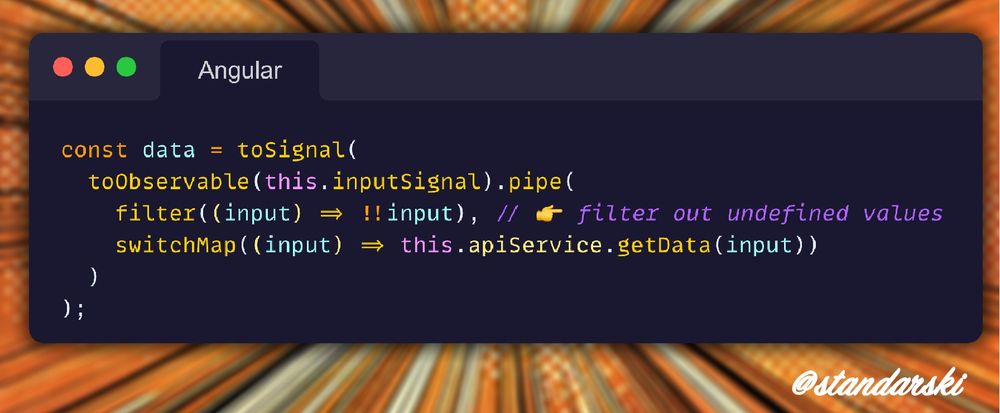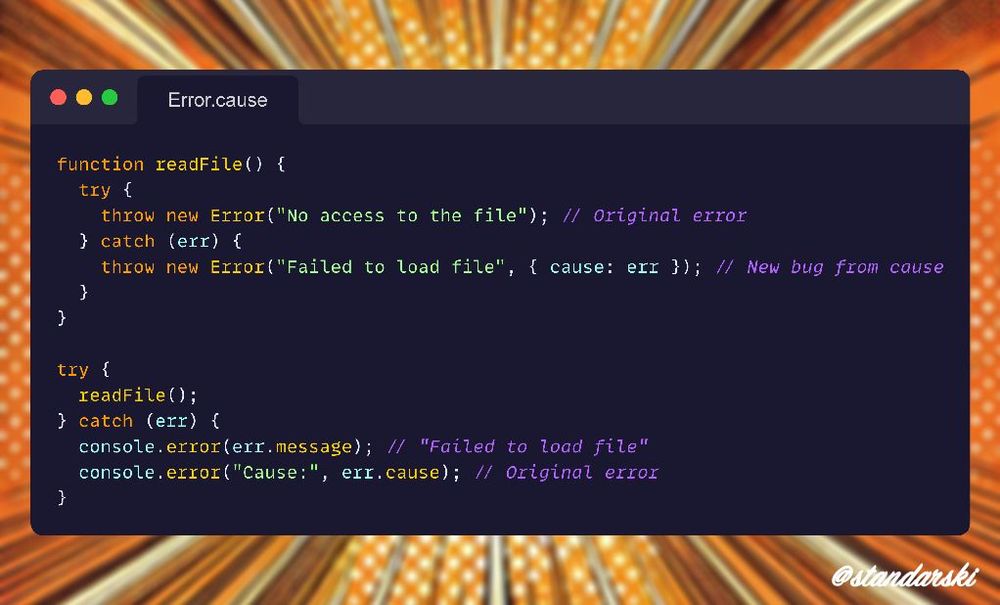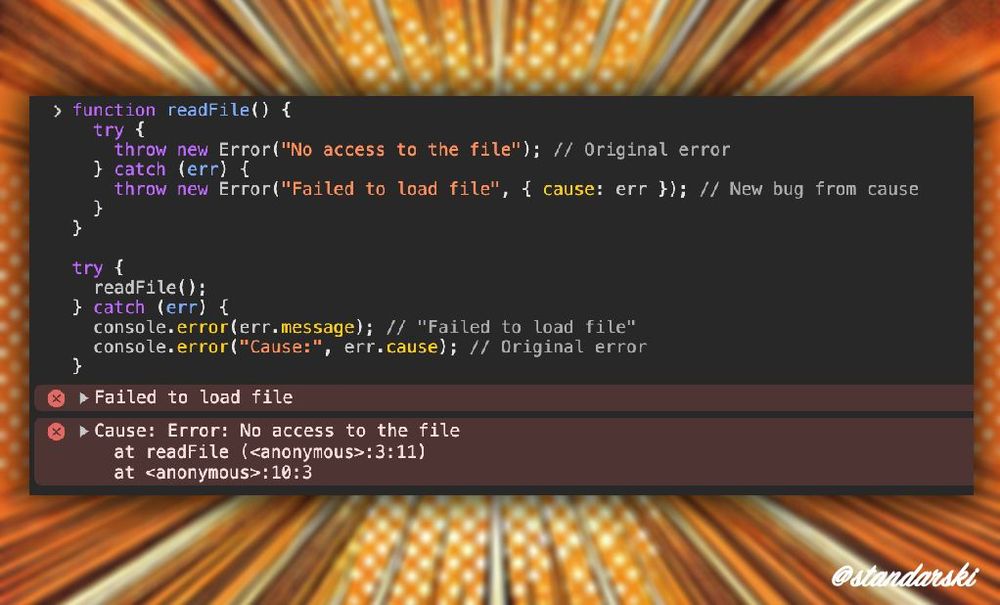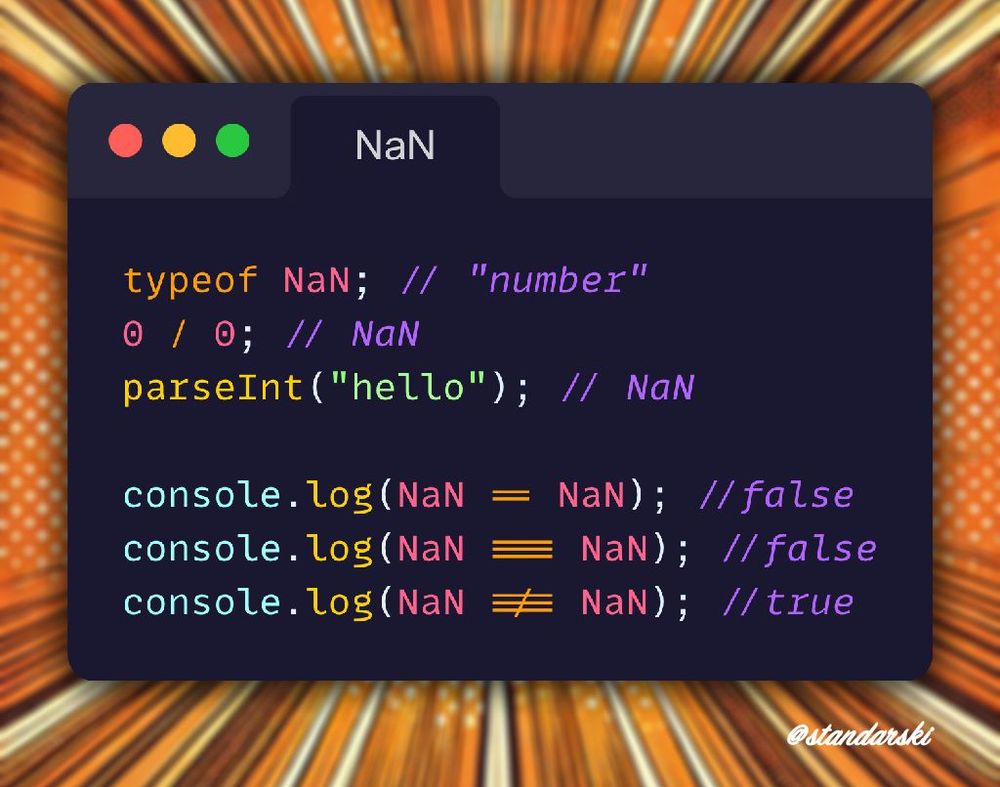
![Code example:
import { Component, HostAttributeToken, inject } from '@angular/core';
@Component({
selector: 'app-example',
template: ` <div [style.color]="color">Content with injected attribute: {{ color }}</div> `,
})
export class AppExampleComponent {
color: string = inject(new HostAttributeToken('color'));
}
// usage
<app-example color="red"/>](https://cdn.bsky.app/img/feed_thumbnail/plain/did:plc:4btsznh33dmfw54blj4uff4l/bafkreigdveuxdvtijiutskrqyxdsc33urwc3zxavoe5k2gsqgwvte6ejv4@jpeg)
Connect toSignal + toObservable for auto-updating API calls!
Check example 👇
No manual subscriptions! Just reactive magic!

Connect toSignal + toObservable for auto-updating API calls!
Check example 👇
No manual subscriptions! Just reactive magic!
Check example and polyfill 👇
![JavaScript Example:
const setA = new Set([1, 2, 3, 4]);
const setB = new Set([3, 4, 5, 6]);
const result = setA.intersection(setB);
console.log(result); // 👉 Set { 3, 4 }](https://cdn.bsky.app/img/feed_thumbnail/plain/did:plc:4btsznh33dmfw54blj4uff4l/bafkreigastl2prutemi6y42jomqxbfnmla6zr2s7etwdatvyi3xnzymmea@jpeg)
![JavaScript example:
if (!Set.prototype.intersection) {
Set.prototype.intersection = function (otherSet) {
return new Set([...this].filter(x => otherSet.has(x)));
};
}
// Test
const setA = new Set([1, 2, 3, 4]);
const setB = new Set([3, 4, 5, 6]);
console.log(setA.intersection(setB)); // 👉 Set { 3, 4 }](https://cdn.bsky.app/img/feed_thumbnail/plain/did:plc:4btsznh33dmfw54blj4uff4l/bafkreifvpsxpjyfhq463kuqhcotkv6wktkhtfvknubspvcvzljcouvgske@jpeg)
Check example and polyfill 👇
Unlike sort(), it does NOT mutate the original array but returns a sorted copy.
Check example 👇
![JavaScript example:
const numbers = [3, 1, 4, 1, 5, 9];
const sorted = numbers.toSorted();
console.log(numbers); // [3, 1, 4, 1, 5, 9] ✅ original
console.log(sorted); // [1, 1, 3, 4, 5, 9] 🔥 new](https://cdn.bsky.app/img/feed_thumbnail/plain/did:plc:4btsznh33dmfw54blj4uff4l/bafkreifz4scokrx7myitlbzdqmuhk2ufgmkbpgoft76j77bb77h4p5l6o4@jpeg)
Unlike sort(), it does NOT mutate the original array but returns a sorted copy.
Check example 👇
Replace an array element without mutation.
✅ with() is cleaner and shorter!
Check example 👇
![JavaScript example:
const arr = [1, 2, 3];
// New in ES2023
const newArr = arr.with(1, 42);
console.log(newArr); // [1, 42, 3]
// Old way (spread with slice)
const oldArr = [...arr.slice(0, 1), 42, ...arr.slice(2)];
console.log(oldArr); // [1, 42, 3]](https://cdn.bsky.app/img/feed_thumbnail/plain/did:plc:4btsznh33dmfw54blj4uff4l/bafkreifa46qecwp734zncu2u3ibbrzknqj5n5rgf2v6hwok624pt6tgiz4@jpeg)
Replace an array element without mutation.
✅ with() is cleaner and shorter!
Check example 👇
Instead of writing:
new Promise(resolve => resolve(myFunction()));
You can use:
Promise.try(myFunction);
✔️ Supports both async and sync functions
✔️ Catching Synchronous Errors
✔️ You can combine async and sync functions
Check examples! 👇
#JavaScript



Instead of writing:
new Promise(resolve => resolve(myFunction()));
You can use:
Promise.try(myFunction);
✔️ Supports both async and sync functions
✔️ Catching Synchronous Errors
✔️ You can combine async and sync functions
Check examples! 👇
#JavaScript
• npm install: 📦 Installs dependencies from package.json, updates package-lock.json if needed. Flexible but slower.
• npm ci: ⚡ Clean, fast install based only on package-lock.json. Reproducible builds, perfect for CI/CD.
💡Tip: In CI? Use npm ci for stability!
#javascript
• npm install: 📦 Installs dependencies from package.json, updates package-lock.json if needed. Flexible but slower.
• npm ci: ⚡ Clean, fast install based only on package-lock.json. Reproducible builds, perfect for CI/CD.
💡Tip: In CI? Use npm ci for stability!
#javascript
Since #ES2023 you can use Object.groupBy() to group array elements based on key!
Check example 👇
Very useful! 🚀 #JavaScript
![JavaScript example:
const users = [
{ name: "Simon", age: 25 },
{ name: "John", age: 30 },
{ name: "Mia", age: 25 }
];
const grouped = Object.groupBy(users, user => user.age);
console.log(grouped);
/*
{
25: [{ name: "Simon", age: 25 }, { name: "Mia", age: 25 }],
30: [{ name: "John", age: 30 }]
}
*/](https://cdn.bsky.app/img/feed_thumbnail/plain/did:plc:4btsznh33dmfw54blj4uff4l/bafkreia7u53ckibpf7my5pryqco5xk3z5n6ufscsjmgosow76znu4ltdz4@jpeg)
Since #ES2023 you can use Object.groupBy() to group array elements based on key!
Check example 👇
Very useful! 🚀 #JavaScript
Easier debugging by preserving the original cause of an error.
When you create a new error object (Error), you can pass an additional cause property that specifies what the original cause was.
Check out an example below 👇


Easier debugging by preserving the original cause of an error.
When you create a new error object (Error), you can pass an additional cause property that specifies what the original cause was.
Check out an example below 👇
Need to debug Angular routes?
✅ Use enableTracing (for traditional RouterModule setup)
✅ Use withDebugTracing() (for standalone APIs)
📌 Both log detailed routing events to the console, helping you debug navigation issues in #Angular!
![TypeScript code example:
import { NgModule } from '@angular/core';
import { RouterModule, Routes } from '@angular/router';
const routes: Routes = [ /* your routes here */ ];
@NgModule({
imports: [RouterModule.forRoot(routes, { enableTracing: true })], // 🔍 Logs routing events
})
export class AppModule {}](https://cdn.bsky.app/img/feed_thumbnail/plain/did:plc:4btsznh33dmfw54blj4uff4l/bafkreig6ukshyapfs7damkkmmmdjwan22lmkswxc4lsfseohxxctxyiuf4@jpeg)
![TypeScript code example:
import { provideRouter, withDebugTracing } from '@angular/router';
const routes: Routes = [ /* your routes here */ ];
bootstrapApplication(AppComponent, {
providers: [
provideRouter(routes, withDebugTracing()) // 🔍 Logs routing events
]
});](https://cdn.bsky.app/img/feed_thumbnail/plain/did:plc:4btsznh33dmfw54blj4uff4l/bafkreihsx3lkrl6m6fl4l42lilxieacneb44sqxy6jqnh57uhjtjmjfy4i@jpeg)
Need to debug Angular routes?
✅ Use enableTracing (for traditional RouterModule setup)
✅ Use withDebugTracing() (for standalone APIs)
📌 Both log detailed routing events to the console, helping you debug navigation issues in #Angular!
NaN stands for “Not-a-Number”, but ironically, it’s of type number! 🤯
You can use Number.isNaN(x) to check if value is truly NaN.
NaN !== NaN (It’s the only value not equal to itself!).
🔥 Why is NaN !== NaN? A JS quirk or a hidden superpower? 🤯
#JavaScript #CodingTips

NaN stands for “Not-a-Number”, but ironically, it’s of type number! 🤯
You can use Number.isNaN(x) to check if value is truly NaN.
NaN !== NaN (It’s the only value not equal to itself!).
🔥 Why is NaN !== NaN? A JS quirk or a hidden superpower? 🤯
#JavaScript #CodingTips
Need to describe that a function returns exactly an empty object {}? Use Record<string, never>!
Why not just {}?
➡️ {} allows adding `any` properties.
➡️ Record<string, never> enforces absolute emptiness. 😎
Perfect for precise type modeling! 🛠️



Need to describe that a function returns exactly an empty object {}? Use Record<string, never>!
Why not just {}?
➡️ {} allows adding `any` properties.
➡️ Record<string, never> enforces absolute emptiness. 😎
Perfect for precise type modeling! 🛠️
Check example! 👇 #JavaScript #CodingTips
![Example in JavaScript:
const originalObject = {
name: "John",
data: {
age: 30,
names: ["Simon", "Tom"],
},
circularRef: null,
date: new Date(),
};
// Adding a circular reference - does not cause an infinite loop
originalObject.circularRef = originalObject; // -> this will cause an error when using JSON.stringify
const clonedObject = structuredClone(originalObject);
// ✅ deep copy!!
clonedObject.data.age = 31;
console.log(originalObject.data.age); // 30
console.log(clonedObject.data.age); // 31
// ✅ dates continue to be dates
console.log(typeof clonedObject.date);](https://cdn.bsky.app/img/feed_thumbnail/plain/did:plc:4btsznh33dmfw54blj4uff4l/bafkreibzi7gbwpazsmdpv7xnm4fg4l5hlltijqs6l6q6xezlis7wm4fxsi@jpeg)
Check example! 👇 #JavaScript #CodingTips

